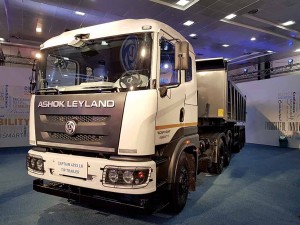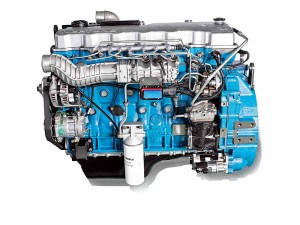In view of the changes affecting the CV industry, Ashok Leyland is banking on technology and innovation.
Story by:
Bhargav TS
After revealing the use of ‘smart’ EGR to help its CVs to comply with BSIV emission norms, Ashok Leyland has announced that it is innovating on various fronts to ensure that its products are relevant, and make a profitable business case. If the ‘Smart’ EGR technology, which the folks at Ashok Leyland call iEGR, has enhanced fuel efficiency by 10 per cent, and minimised the usage of electronics; have kept the weight constant and reliability good, the innovation is also expected to result in lighter, safer, efficient and world-class products. According to the chief technology officer Dr. Seshu Bhagavathula, the company is planning three upgrades to address a shift to CVs with higher power to weight ratio, and CVs with fully-built AC cabins. This, mentions Bhagavathula, will occupy our time and effort.
Market vibes
With the rise in operating speeds set to change the way the long haul segment operates, Ashok Leyland is finding an opportunity to innovate. It also stems from the need to match the duty cycle requirements; the need to change engine calibration parameters, and to collect data. “All this will have to be done in the next couple of years,” mentions Bhagavathula. He explains, “EGR is suitable for Indian conditions rather than SCR. SCR can be offered at the price of an EGR, but will result in higher maintenance cost.” Connecting higher maintenance cost of SCR to the need for urea dosing and electronics, Bhagavathula opines, “SCR systems are not bad. It is EGR that we believe will help our CV users in the long run.” A function of engine as much as it is the function of fuel quality, driver and the road conditions, EGR, mentions Bhagavathula, offers the advantage of less number of parts. The bill of materials is better. “We researched. We collected data. We found out that EGR is less complex,” he reveals.
If the ‘smart’ EGR developed by Ashok Leyland has the ability to help a 400 hp engine to meet BSIV emission norms, much work has gone into the tweaking of the cooling system, the exhaust gas control valve among others. The in-cylinder combustion process was optimised. “We combined intelligence with EGR. We gave five per cent back and a maximum of 10 per cent exhaust gas instead of 20 per cent. The intelligence thus is in the combustion chamber, and not at the EGR level. It reduces the role of a Particle Oxidation Catalyst (POC), and could even eliminate it. We optimised in-cylinder temperature as well,” Bhagavathula elaborates.
Optimising injection pressure by modifying the design of the nozzle, Ashok Leyland engineers claim to have upped the fuel efficiency, and the life of the engine. Planning to keep the electronic content to the bare essential, the CV maker is keen to gradually increase the complexity of its products. The current efficiency of the engine at around 40 per cent, states Bhagavathula. It leaves enough potential for improvement, he adds. Touching upon the potential to improve material technology, Bhagavathula opines, “Over 60 per cent of the engine efficiency can be achieved by using fine materials. There will be no corrosion or sound, and hardly will there be a need for oil.” Hoping that one fine day it will be possible to arrive at such a development in real-time, Bhagavathula draws attention to the engines they make. We make our own engines, and not source them, he says.
Tech upgrade
At Ashok Leyland, a separate team is working to improve the combustion process. Products that have higher power to weight ratio will be launched. Also launched will be CVs with a power output of more than 400 hp. According to Bhagavathula, 49-tonne vehicles with 180 and 190 hp will rise to 200 and 220 hp. The AC cabs, he adds, will flaunt a different level of fit and finish. The use of light weight material is set to increase, states Bhagavathula, the future lies with the suppliers, and how they could help reduce the cost of the end product. Ashok Leyland is closely following alternate fuel technology developments. In the electric vehicle space, it is working on new management strategies. They are about controlling the vehicle and battery functions.
With Optare, Ashok Leyland has developed a strategy to enhance the bus range by 45 per cent. Efforts are being made to access new technologies. Reveals Bhagavathula, “Fruitful exchange of technologies is taking place.” In the direction of connected CVs, the work on driver warning systems is underway. Three systems would be offered. The basic system will warn the driver. The mid-level system will address the needs of fleet operators that are keen to deliver their cargo on time. The premium-level system is autonomous, and engineered to offer complete control. What Ashok Leyland currently offers is ‘iAlert’ and ‘Ley Assist’. ‘iAlert’ improves viability through state-of-the-art, innovative, user-friendly, and cost effective services. Through the ‘Ley Assist’ app., the owner or driver can avail of all the information about the truck through Bluetooth. This includes information about the problems faced too.
Full-range strategy
Keen to become a full range player, Ashok Leyland will launch one new product every three months for the next two years. With an aim to bag 30 per cent of the LCV market, the company is planning to invest Rs.400 crore over the next two years for LCVs. An electric LCV range is also said to be on the cards, and would be soon unveiled. With the Indian CV market set to change, it is natural of Ashok Leyland to innovate. It will not just benefit the CV buyer, but also the society at large.






















